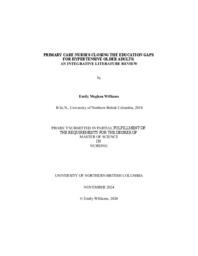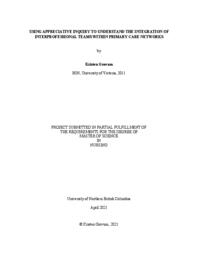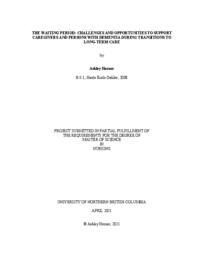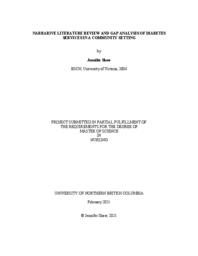University of Northern British Columbia. Nursing
Related Works
Content type
Digital Document
Origin Information
Content type
Digital Document
Description / Synopsis
The high prevalence of hypertension among the Canadian older adult population is a significant public health care issue. The evidence indicates that primary care nurses are crucial in providing high-quality care and education for older adults diagnosed with hypertension. Further, nurses can close education gaps by focusing on lifestyle modification and action strategies. This project aimed to conduct an integrative literature review investigating the proposed research question: “How can nurses close the educational gaps for older adults diagnosed with hypertension by addressing the risk factors in the primary care setting?” A comprehensive search of several databases retrieved 19 primary sources that provided evidence related to hypertension education for older adults. The following themes emerged from the research: hypertension education, knowledge translation tools, barriers, cultural sensitivity and inclusivity, therapeutic interpersonal relationships, and a collaborative approach. A gap analysis was conducted in Prince George, British Columbia. The gap analysis further solidified the evidence found in the primary research. Recommendations for enhancing education, practice, and future research are discussed concerning hypertension education based on nurse encounters with older adult patients in the primary care setting. The findings from this project have important implications for supporting the nurse’s educational role in the treatment and management of hypertension among the older adult population.
Origin Information
Content type
Digital Document
Description / Synopsis
Background. Adolescents are losing the opportunity to observe and practice food skills since diets are shifting from home prepared meals made from basic ingredients to a diet comprised of ultra-processed foods, resulting in reduced consumption of minimally processed foods such as fruits and vegetables. Evidence suggests that engaging in food preparation during adolescence is associated with ongoing healthy dietary behaviours and food preparation practices into adulthood, thus developing food preparation skills in adolescence may help better support individuals to make health informed food choices. Food literacy represents the interdependent concepts related to the facets influencing dietary practices. The objective of the current study was to examine the association between food literacy and fruit and vegetable consumption (FVC) among Canadian adolescents. Methods. Guided by the food literacy framework developed by Thomas et al. (2019), a secondary analysis was conducted on the Canadian Community Health Survey, Rapid Response on Food Skills (Part 2) – mechanical skills and food conceptualization. The sample population (N=790) included all survey respondents aged 12- 17 years who responded to the survey questions that built the outcome variable: total daily fruit and vegetable consumption. Results. When compared to respondents who report low levels of food skill, respondents who reported high food skill levels in the ability to cook from basic ingredients (OR 1.84, 95% CI 1.12-3.02), freeze vegetables from raw (OR 1.50, 95% CI 1.00-2.24), and to adjust a recipe to make it healthier (OR 3.02, 95% CI 1.29-3.26) were more likely to consume fruits and vegetables five or more times a day. Respondents who came from households where the highest level of household educational attainment was trades had lower odds of consuming fruits and vegetables five or more times a day compared to households where the highest level of educational attainment was a bachelor’s degree or higher (OR 0.34, 95% CI 0.14-0.81). Within the logistic regression model, significant relationships were found between FVC and a respondent’s sex (p=0.04), perceived eating habits (p<0.001), and highest level of household educational attainment (p=0.02). Discussion. Significant relationships between FVC and food literacy were evident in food skills that were multifaceted, requiring that adolescents have the ability to perform a number of basic food skills and reflective of several food literacy attributes. The relationships found between multifaceted food skills and adolescent FVC suggest that food literacy attributes are interconnected and have reciprocal relationships. Conclusion. Dietary behaviours are influenced by multiple factors. Study findings suggest that higher levels of adolescent food literacy, as reflected in multifaceted food skills, have the potential to positively impact their FVC. However, when societal factors are controlled for, food skills were not found to have a significant relationship with adolescent FVC, suggesting that factors outside of the control of the individual have the potential to minimize the influence of individual food literacy characteristics on adolescent FVC. Future food literacy programs should be inclusive of adolescents from all SES and should aim to teach and evaluate food literacy attributes that build more complex food skills.
Origin Information
Content type
Digital Document
Description / Synopsis
Over the past fifteen years, primary care networks have been established across Canada; spaces whereby people can access a first point of contact with healthcare professionals focused on chronic disease management, health maintenance, and prevention. British Columbia has recently launched a model of primary care networks and interprofessional teams in response to a current health system challenged with demands related to an aging population and increased prevalence of chronic disease and disability. Using appreciative inquiry for understanding organizational social system change, information was gathered to explore the strengths and directional change needed as shared by primary care providers and case managers working in a Vancouver Island health authority primary care network. The purpose of the project was to understand how these providers could work more effectively within integrated interprofessional teams. Actions focused on the process of facilitating connection, communication, relationship, collaboration and autonomy within these networks are explicated.
Origin Information
Content type
Digital Document
Description / Synopsis
Transitions to long-term care are significant and often challenging experiences for older adults with dementia and their caregivers, with waiting lists a common occurrence due to an aging population and a limited supply of long-term care beds. To better understand the complexities related to transitions to long-term care and inform clinical practice, a comprehensive project was undertaken and included an integrative literature review and a gap analysis of local practices in the interior of British Columbia. The literature review and gap analysis findings were analyzed and presented thematically through interrelated themes, including key concepts surrounding the phases of a transition, caregiver coping, and professional support. Four key recommendations arose from this project regarding continuity and coordination of care, discharge planning, post-discharge care, and evaluation. The strengths, limitations, and implications of this project are discussed, including next steps to mobilize knowledge related to the recommendations and influence evidence-informed changes in practice.
Origin Information
Content type
Digital Document
Description / Synopsis
Pediatric patients in northern BC have some of the highest asthma prevalence rates compared to children in other areas of the province. Adequate parental health literacy skills are particularly important to make informed health management choices when caring for children with asthma. In this project, a gap analysis process was followed, and three evidence-informed practice gaps related to pediatric asthma care were identified. Findings highlight the need for increased asthma education and parental health literacy resources to address concerns mentioned during stakeholder engagement. Four key recommendations were formulated regarding parental health literacy assessments, clear language requirements for written asthma materials, access to specialized care resources, and adaptation of current asthma education models. In conclusion, the development of a working group that includes asthma and health literacy stakeholders, is the next step to address the findings of this project and improve the overall asthma health outcomes for children in northern BC.
Origin Information
Content type
Digital Document
Description / Synopsis
The goal of this project was to outline best practices regarding the organization of diabetes care and services in the community in relation to the local context of services in Squamish, BC, Canada to create a foundation for future quality improvement work. The theoretical framework of personcentered care is essential to chronic disease management and underpins this work. The methods include: 1) A narrative literature review consisting of a database search, and 2) A gap analysis consisting of local data and an environmental scan. The Chronic Care Model is an evidence-based integrated care framework used to organize the findings of the narrative literature review and the gap analysis and to frame the recommendations (Clement et al., 2018). Based on the findings, evidence-based recommendations were created specific to the context of diabetes care in Squamish, BC creating the opportunity for meaningful future quality improvement work.
Origin Information
Content type
Digital Document
Description / Synopsis
This integrative literature review strives to determine if the delivery of reproductive and sexual health services provided through high school-based primary care clinics can improve BC adolescent sexual and reproductive health. Adolescent sexual and reproductive health not only impacts life-long health; it also has significant societal implications. Although BC has begun to focus on adolescent health, innovative health service solutions are needed to improve adolescents’ health. Systematic search through the University of Northern British Columbia online library databases and Google scholar and the evaluation of the literature using CASP analysis tools resulted in the inclusion of 10 articles. Findings suggest school-based health clinics (SBHCs) decrease barriers that adolescents experience when accessing health services as well as public health system costs. Moreover, SBHCs are an effective mechanism to support adolescent reproductive and sexual health needs, especially in those populations with elevated levels of sexual and reproductive risk factors. However, for SBHCs to be effective, sustainable funding needs to be sourced, and barriers adolescents experience when accessing services need to be evaluated and addressed. SBHCs can complement current adolescent-friendly services to meet this unique population’s needs; however, further research is needed. More robust research on various demographics, health outcomes, and Canadian-based examination is required to strengthen SBHC implementation recommendations.
Origin Information
Content type
Digital Document
Description / Synopsis
Primary care providers (PCPs), including nurse practitioners and primary care physicians, experience significant occupational stress, putting them at risk for chronic stress and burnout. Burnout rates are high amongst PCPs, and results in negative health effects that can impact the personal life of the PCP, as well as professional outcomes and patient care. Mindfulness has been shown to reduce anxiety and burnout symptoms, and improve healthcare provider well-being. Using an integrative literature review methodology outlined by Whittemore and Knafl, this paper explores if a mindfulness practice can reduce stress and burnout symptoms for PCPs. The results are discussed within the context of a primary care setting in Canada. Relevant literature was searched and a selected sample of ten primary research articles was selected for further analysis. Results suggest that mindfulness interventions are effective for reducing stress and burnout symptoms for PCPs, but access to these interventions may be a barrier to successful implementation of a mindfulness practice. In a primary care setting in Canada, PCPs are encouraged to attend mindfulness interventions and incorporate learned components into their practice, thereby increasing patient-centered care. Recommendations for reducing stress and burnout symptoms for PCPs are discussed, and specific strategies for successful implementation of mindfulness interventions are provided.
Origin Information









